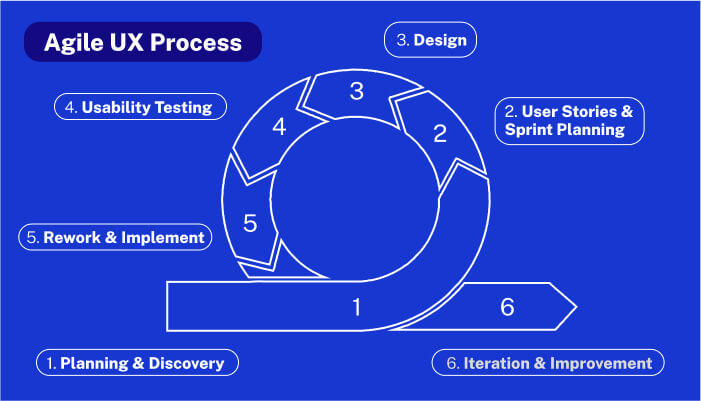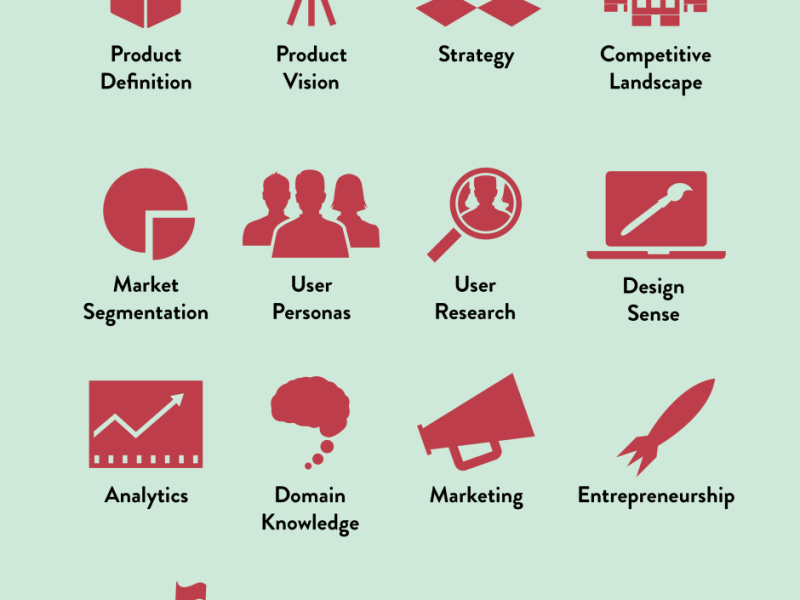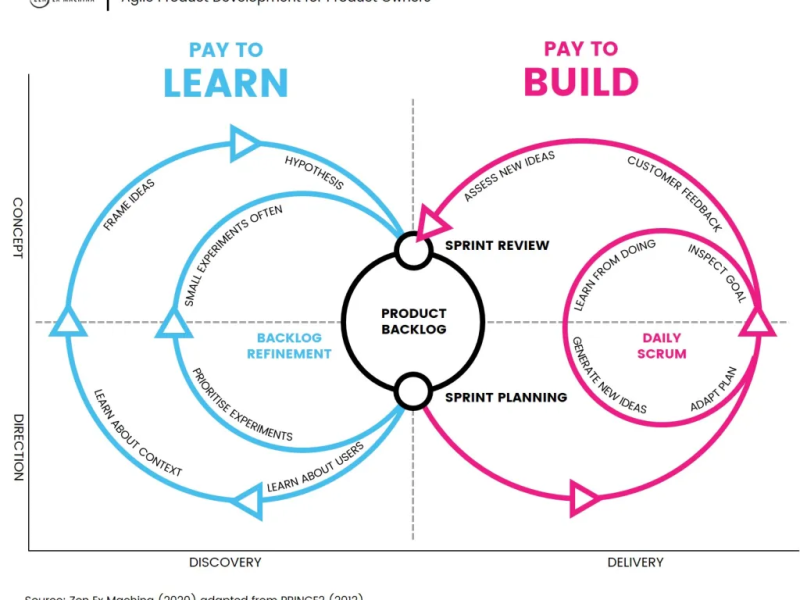Agile UX is a user experience design methodology that integrates seamlessly with Agile software development principles.
It emphasizes collaboration, flexibility, and continuous iteration to create user-centric and high-quality products.
Rooted in the Agile Manifesto, this approach brings together cross-functional teams—including designers, developers, product managers, and stakeholders—to deliver incremental improvements that align with user needs and business objectives.
The Core Tenets of Agile UX
- Collaboration Across Teams: Agile UX thrives on cross-disciplinary collaboration. Designers, developers, and product managers work closely to ensure the product meets user expectations and aligns with technical feasibility and business goals. Regular communication helps bridge gaps between design and development, fostering a shared understanding of priorities and constraints.
- Continuous Iteration: Iteration is the heart of Agile. Teams create prototypes, test designs with real users, and refine them based on feedback. This cyclical process ensures the product evolves with user needs, market demands, and technological advancements.
- User-Centered Design (UCD): Agile prioritizes the needs and goals of users. By conducting user research—interviews, surveys, and usability testing—designers gather insights that inform decision-making. The result? A product that is intuitive, accessible, and delightful.
- Rapid Prototyping: Quick prototyping enables teams to visualize ideas and test assumptions early. This practice minimizes risks, reduces development costs, and accelerates time-to-market by identifying issues before substantial resources are invested.
- Design Thinking: Design thinking complements Agile UX by fostering creativity and problem-solving. Empathy, ideation, and experimentation drive innovative solutions that resonate with users while meeting technical and business requirements.
- Adaptability and Flexibility: Agile embraces change, allowing teams to respond to new information, shifting priorities, or emerging trends. This adaptability ensures the final product remains relevant and valuable.
Benefits of Agile UX
1. Enhanced User Experience
By involving users throughout the design process, Agile UX ensures the product is tailored to their needs and expectations. This leads to higher satisfaction, loyalty, and engagement.
2. Faster Development Cycles
Agile UX promotes rapid iteration and prototyping, enabling teams to identify and address issues quickly. This accelerates development timelines while maintaining high-quality outcomes.
3. Improved Collaboration
Collaboration among team members ensures that design decisions align with development capabilities and business objectives. This cohesive approach minimizes silos and fosters a shared vision.
4. Greater Flexibility
The iterative nature of Agile UX allows teams to adapt to changing requirements, market conditions, or user feedback without disrupting workflows.
5. Alignment with Business Goals
By focusing on delivering user value, Agile UX helps businesses achieve their objectives. Whether it’s increasing conversions, reducing churn, or enhancing brand perception, this approach bridges user needs and organizational success.
Common Challenges and Pitfalls in Agile UX
While Agile offers numerous advantages, implementing it effectively can be challenging. Here are some common mistakes to avoid:
1. Neglecting User Involvement
Agile depends on continuous user feedback. Failing to involve users can result in designs that miss the mark, wasting time and resources.
2. Ignoring Design Principles
While speed and flexibility are important, they should not come at the expense of usability, aesthetics, or consistency. Balancing these elements is crucial for a successful product.
3. Poor Communication
Agile relies on open communication among team members. Miscommunication can lead to delays, rework, and frustration.
4. Lack of Prioritization
With frequent iterations, it’s easy to lose sight of priorities. Clear goals and a well-maintained backlog ensure the team focuses on what matters most.
5. Resistance to Change
Adopting Agile UX requires a cultural shift. Teams resistant to new workflows or tools may struggle to embrace its principles fully.
Implementing Agile UX: Best Practices
1. Embed UX Designers in Agile Teams
Having dedicated UX designers within Agile teams ensures design considerations are integrated into every sprint. This setup promotes collaboration and accountability.
2. Timebox Design Activities
To align with Agile’s pace, UX activities—such as research, prototyping, and testing—should be time-boxed. This ensures progress without compromising quality.
3. Leverage Tools and Frameworks
Tools like Figma, Sketch, and Adobe XD enable rapid prototyping and collaboration. Frameworks like Lean UX and Double Diamond provide structured approaches to problem-solving.
4. Prioritize Usability Testing
Regular usability tests provide actionable insights that guide design improvements. Testing early and often reduces risks and ensures user needs remain central.
5. Foster a Culture of Feedback
Encourage open feedback within teams and from users. Constructive critique enhances designs and strengthens team dynamics.
Real-World Examples of Agile UX Success
- Spotify: Spotify’s design process exemplifies Agile. The company’s squads—small, autonomous teams—iterate on features based on user feedback, ensuring a seamless and engaging experience.
- Airbnb: Airbnb leverages rapid prototyping and usability testing to refine its platform. By prioritizing user feedback, the company delivers intuitive interfaces and delightful interactions.
- Google: Google’s use of design sprints—a time-constrained, iterative process—allows teams to solve complex problems quickly while keeping user needs at the forefront.
Key Metrics to Measure Success
To evaluate the effectiveness of Agile UX, track the following metrics:
- Task Success Rate: Measures the percentage of users who complete a task successfully.
- Time on Task: Tracks the time users spend completing tasks to assess efficiency.
- Net Promoter Score (NPS): Gauges user satisfaction and likelihood to recommend the product.
- Error Rate: Monitors the frequency of user errors during interactions.
- Customer Retention: Indicates how well the product meets user needs over time.
Final Thoughts
Agile is a transformative approach that bridges the gap between design and development, ensuring products are user-centric, adaptable, and aligned with business goals.
By embracing collaboration, iteration, and user feedback, teams can create experiences that delight users and drive success.
For organizations looking to adopt Agile, start small, iterate, and continuously refine processes. With commitment and practice, Agile UX can become a cornerstone of your design and development strategy.
References
- “Agile UX: Principles and Practices.” Nielsen Norman Group. https://www.nngroup.com
- “The Agile Manifesto.” Agile Alliance. https://www.agilealliance.org/agile101/the-agile-manifesto/
- “Design Thinking in Agile UX.” Interaction Design Foundation. https://www.interaction-design.org/
- “UX Metrics to Measure Success.” Smashing Magazine. https://www.smashingmagazine.com/


